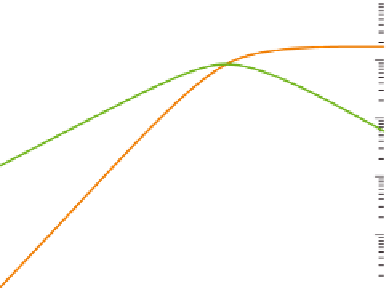Biomedical Engineering Reference
In-Depth Information
10
3
10
2
10
1
10
0
10
-1
G
'
G
”
10
-2
3x10
-2
10
-1
10
0
10
1
10
2
ω
(rad s
-1
)
Storage and loss moduli versus angular frequency for HM poly(acrylamide): M
w
= 1.6 × 10
5
g
mol
−
1
at c = 5% w/w with a hydrophobic block length of 7 units and 3.2 hydrophobic blocks per
chain. Adapted with permission from Regalado et al.(
1999
) © 1999 American Chemical Society.
Figure 6.10
inter-chain associations, a cross-linking effect which will depend on molecular compo-
sition, and which was a maximum with only a few associating groups per chain. The
model applied to solutions with concentrations slightly above c*, and maximum viscos-
ity was achieved when the time scale of deformation (or inverse of the shear rate) became
shorter than the molecular relaxation time. At even higher shear rates, the stress was large
enough for the rate of rupture to prevent inter-chain junctions re-forming (Lundberg
et al.,
1991
), and shear thinning was again observed.
Dynamic oscillatory measurements of HM water-soluble polymers exhibit a frequency
dependence which corresponds to that of a viscoelastic liquid. A typical spectrum is shown
in
Figure 6.10
. At low frequencies, the behaviour of the shear moduli is Maxwellian: G
0
(
ω
)
2
and
and G
00
(
, respectively. Then, at a certain angular frequency, the curves
cross over each other and the inverse is taken as a characteristic time of the polymer
solution. Deviations from this Maxwellian behaviour appear before the crossing point and
especially at the high-frequency limit, and the shape of the curves at high frequency
indicates higher relaxation modes. For telechelic HEUR associative polymers, by contrast,
the dynamic spectrum shows almost perfect single Maxwell relaxation, in agreement with
the Tanaka
ω
) scale like
ω
ω
Edwards model. At room temperature and moderate concentrations, this is also
the case for PEO capped at one or both ends with hexadecyl groups (Renou et al.,
2009
). In
many other systems, the spectrum contains more than one Maxwell element, and appears
more like the Rouse
-
-
Zimm type spectrum seen for
'
simple
'
polymer solutions.
6.5
Interaction with surfactants
One of the characteristic features of HM water-soluble polymers is the very speci
c
interactions that they have with surfactants, whereby hydrophobic interactions occur











































Search WWH ::

Custom Search